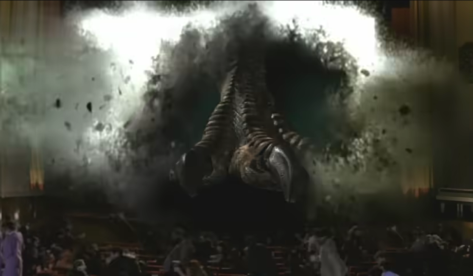
One of the more distinctive cultural legacies left by Sony/Tristar’s 1998 Hollywood blockbuster incarnation of Godzilla is all the myriad ways the studio attempted to transform it into the apex example of a four quadrant multimedia hype machine. Not surprisingly, that’s also one of the major criticisms of it: that the marketing was just as important as the actual content of Roland Emmerich and Dean Devlin’s film, if not more so—the movie’s “Size Does Matter” tagline representing their ambitions to outdo the previous decade’s worth of summer crowd-pleasers in every respect. So, trailer campaigns, promotional tie-ins with places like Taco Bell, toys, and Saturday morning cartoons were not just there for a little extra dosh on the side, but a core part of the entire endeavour—and the general short-to-medium-term disinterest that audiences showed those tie-ins ultimately did more harm to a potential American-led Godzilla’s franchise potential than even the poisonous critical reception did. The movie being mostly hype was its downfall when it was the hype inevitably died down.
Among the products produced for the movie was, of course, the soundtrack of “inspired by” rock/pop tracks whose presence in the movie was mostly optional, although the singles and their tied-forever-to-the-movie music videos were key parts of the marketing campaign. Compared to the toys and other merch, Godzilla: The Album was actually fairly successful, a platinum seller in multiple countries with singles that charted on various Hot 100s. This was at a time when every major motion picture had a similar tie-in soundtrack, and most of them sold regardless of the general opinion of the movie—the only explanation is this was the peak CD era, and you had to actually put in the effort to not sell at least a million discs.
Godzilla: The Album did not have the high concept hook of previous soundtracks for summer disappointments like Spawn, which featured collabs between heavy metal and electronica musicians—closer in spirit to the soundtracks to the Joel Schumacher Batman films, it is instead a repository of mostly alternate rock and other popular genres of the late nineties, a clear attempt to make the music associated with Godzilla ’98 contemporary and “cool.” However, a more accurate description is that it’s a repository of the bloodless form of alternative rock that shambled on through our radios after the boom period in the first half of the nineties inevitably collapsed—it’s a real mishmash of veterans of the genre like Foo Fighters and Rage Against the Machine, mostly forgotten newcomers like Fuel and Fuzzbubble, as well as semi-associated artists like Ben Folds Five, just to give you the discombobulating experience of going from hard rock and rap to piano to whatever the heck Joey DeLuxe is supposed to be. The tracks themselves are a mix of written-for-the-soundtrack entries, established deep cuts (like Silverchair’s solid “Untitled”), and weird hybrids like Green Day’s “Brain Stew (The Godzilla Remix)”, where their insomniac anthem is interspersed with samples of Godizlla’s trademark roar. As you can tell, some of the contributors put more effort into this than others, and some put in effort that they eventually felt was not worth it—Foo Fighters were apparently excited to create a song for a Godzilla movie, right up until they actually saw the Godzilla movie they created a song for.
Lost in all of this pure 1998 marketing buzz is Godzilla…you know, the popular monster on which the film is supposedly based. One would assume that Godzilla would be a bit central to the whole project, especially since the aforementioned marketing push seemed to be based on the notion that the world’s most popular giant monster should be able to handily scale up every accomplishment of something like Jurassic Park. So, the state of alternative rock and pop music in 1998 is one thing, but the real question remains: what does any of this have to do with Godzilla? For a good chunk of the songs, the answer is often “nothing, really”, and that sometimes even applies to original songs produced specifically for this album. But surely there was some thought process behind the lead singles in particular, some inkling of what kind of song would be appropriate for the King of the Monsters. The only way to know for sure is to look at each of them and suss out their radioactive DNA.
Continue reading Godzilla: The Album




